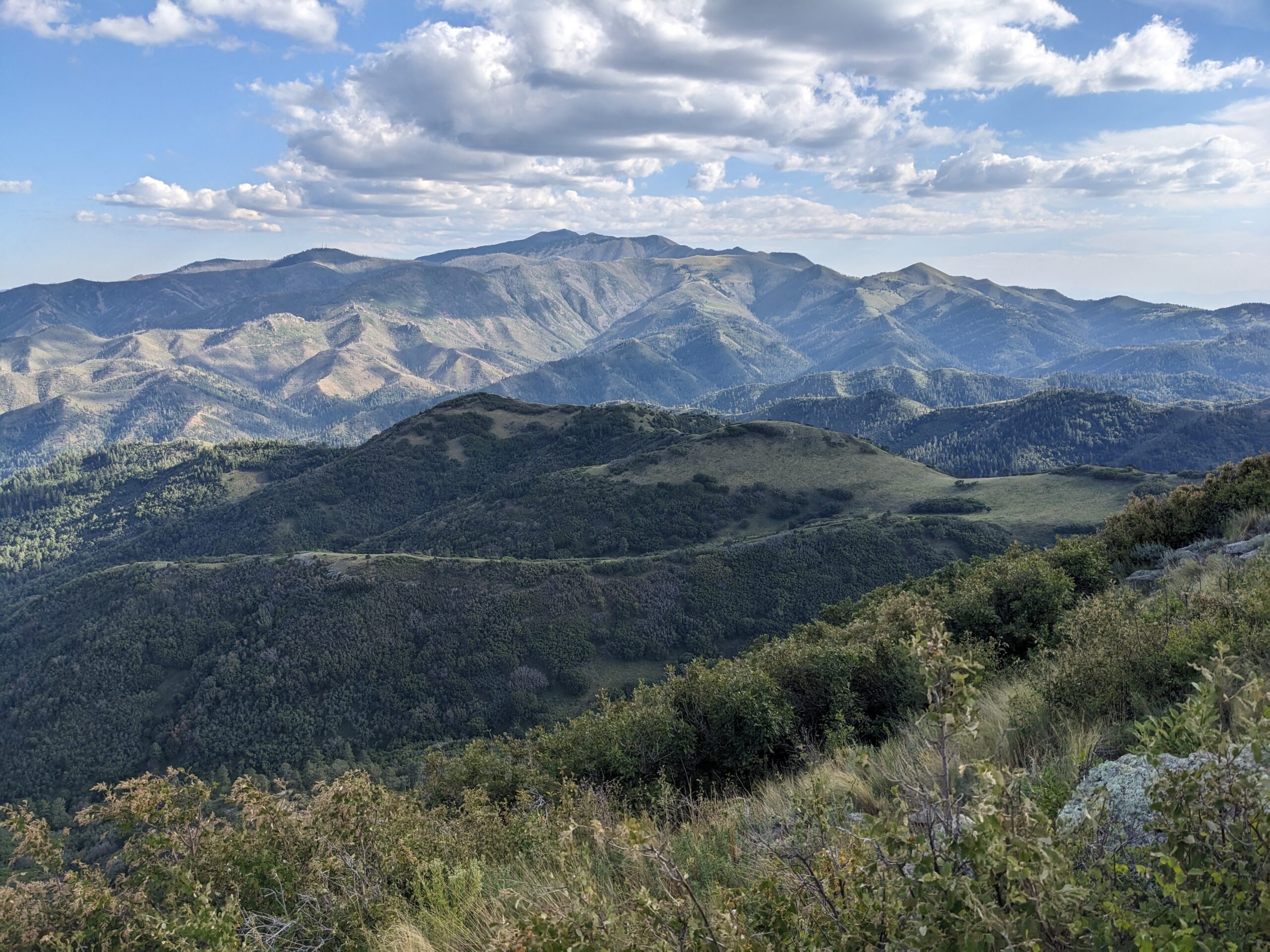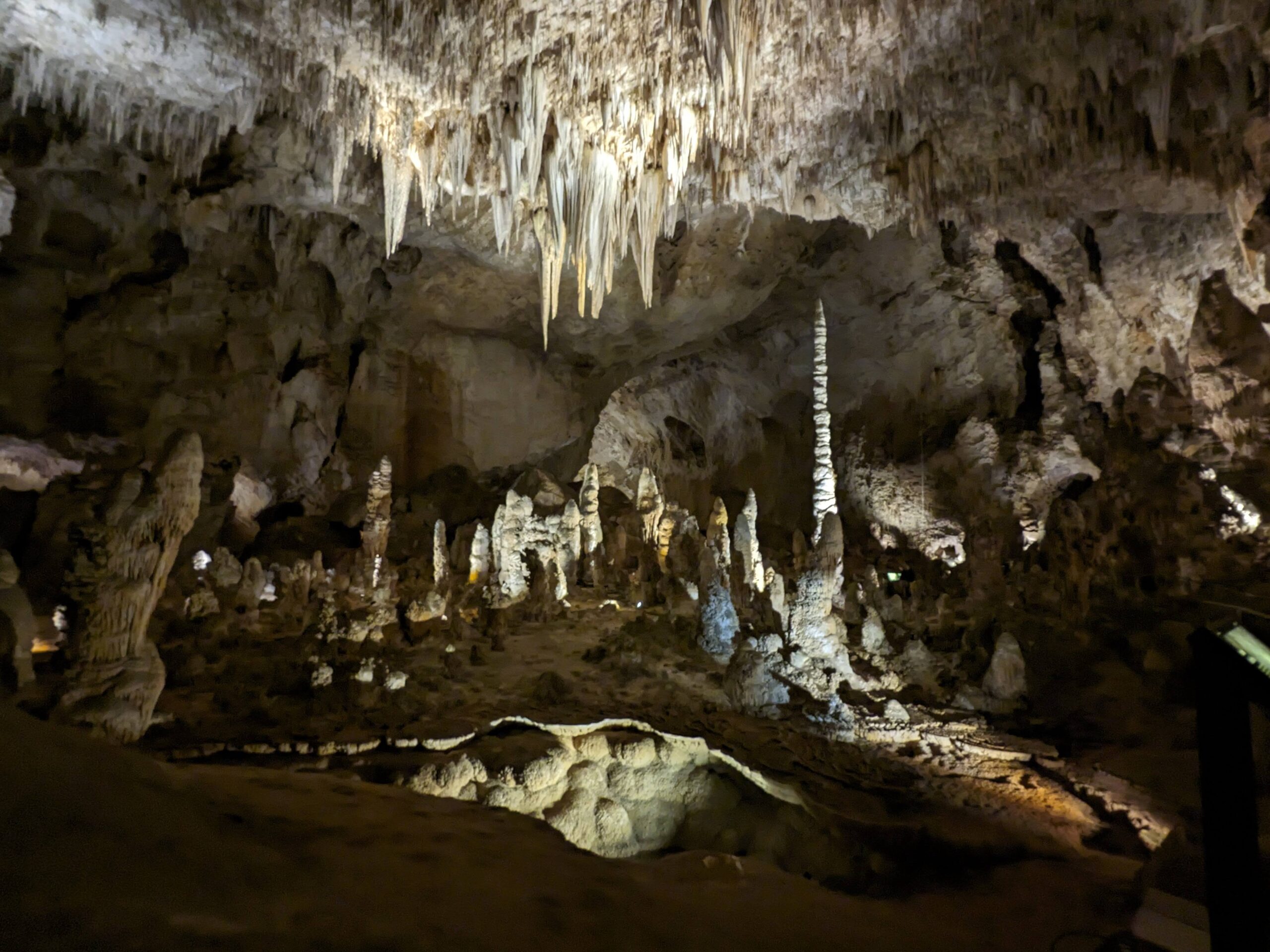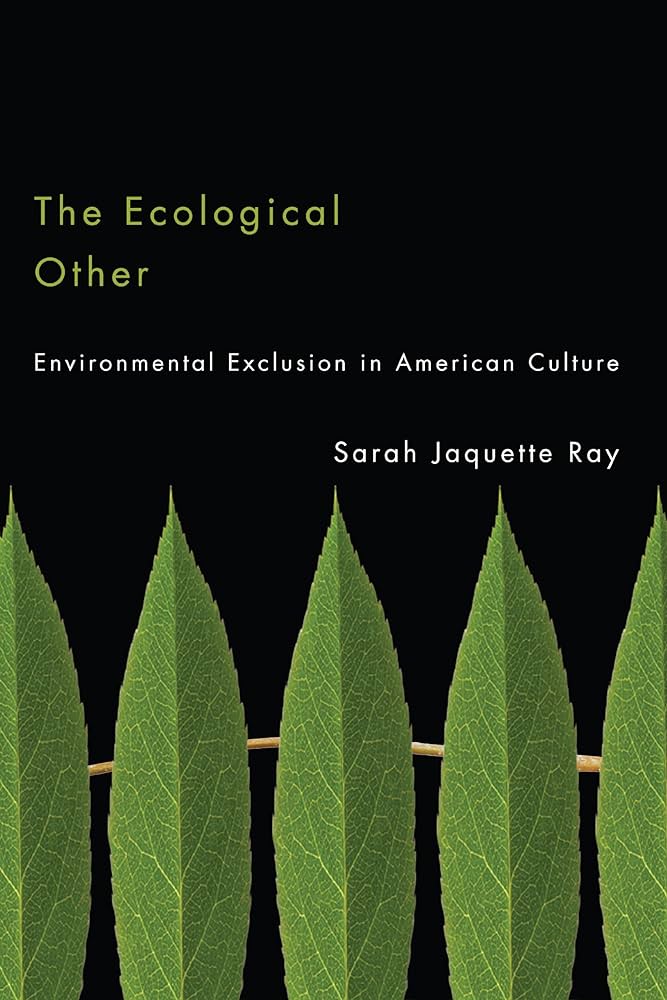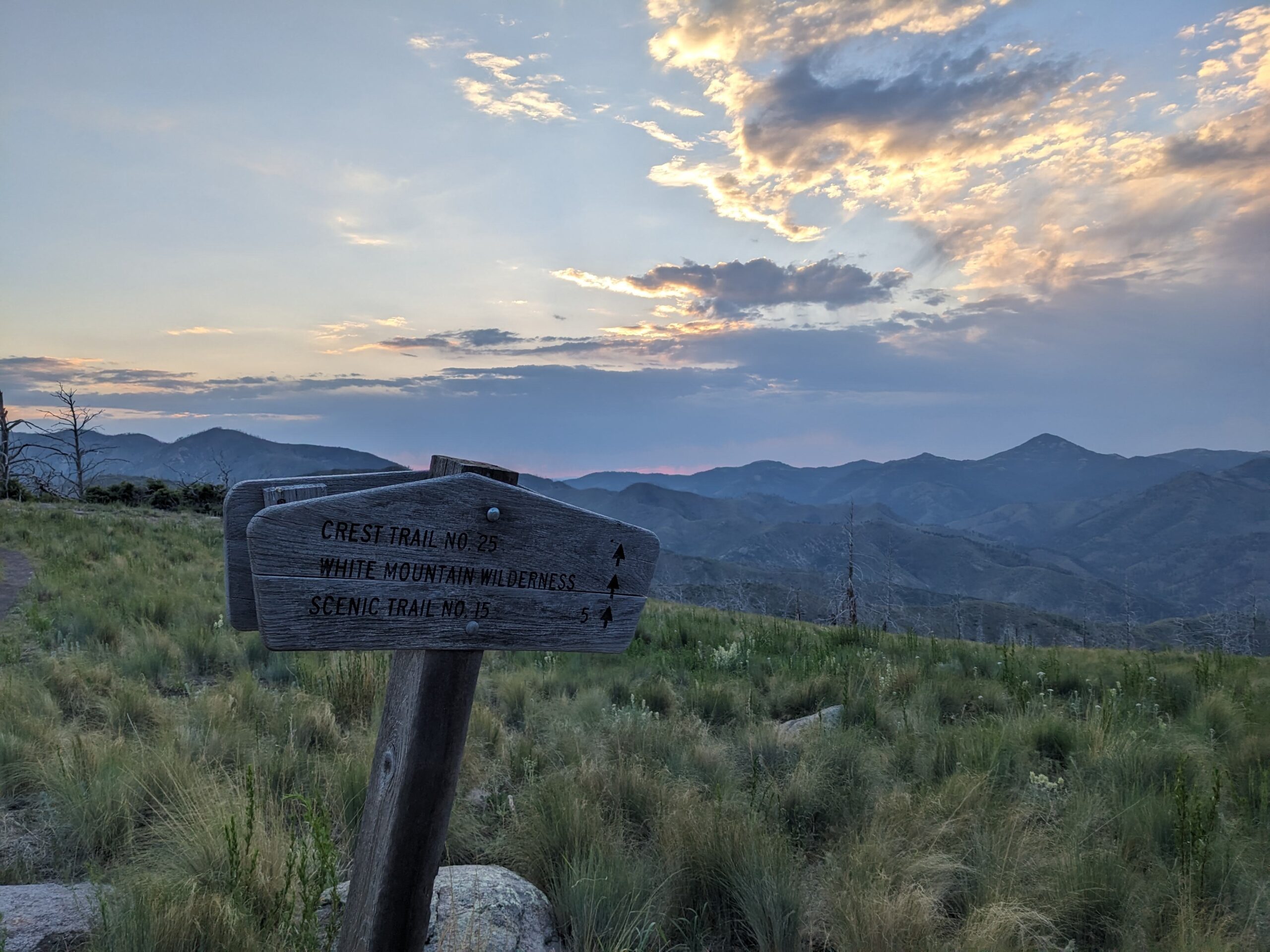
I’ve had trouble fitting in post-work hikes with the days rapidly shortening. Earlier this month, I made the time to climb Nogal Peak (9,957′), which juts out from the surrounding pinyon-juniper hills. Despite being a 2.5-mile hike, it features 1300 feet of elevation gain in one mile. Goodding’s Onion and Sacramento Mountain Prickly Poppy surveys were comparable in difficulty but in their own way. The following weekend, I found myself at the deepest point in Carlsbad Caverns open to the public–King’s Palace–which rests 840 feet below the desert surface.

Something that’s been bothering me since diving into my botanical obsession during the start of COVID-19 is my internalized perception of designated “natural” spaces like Nogal Peak and Carlsbad Caverns. These spaces include National Parks, Forests, Wilderness Areas, Refuges, State Land, and Preserves. Spending the whole summer working and recreating in National Forests, Parks, and Monuments has caused this concern to resurface.
The Pandemic incentivized me to explore as much of Ohio as possible and reconnect with where I grew up. One of the first places I visited was Brown’s Lake Bog State Nature Preserve–a biodiverse rarity just half an hour’s drive from my house. Pitcher plants, cranberries, orchids, sundews, and sedges ensnared my younger rapacity for learning the local flora. Even cooler is the geologic history of the bog, as it’s an example of a “kettle hole,” hinting at Ohio’s glacial past. Kettles are typical features of glacial landscapes, formed by chunks of ice that break off from a retreating glacier, leaving a depression in the ground from their weight. As they melt, water and organic matter fill the depressions. If there is enough decomposing organic matter, the water acidifies, creating a bog. Hazel Willis Woods, Malabar Farm State Park, and Mohican State Park are formative places from my childhood that I revisited during the Pandemic (in addition to numerous State Nature Preserves like Brown’s Lake Bog). These spaces provided the opportunity to teach me about the area’s natural history in greater depth than as a child. I felt like I was rereading a book for the first time in 10 years with a new (but flawed) perspective.
In areas with varying levels of recreational pressure, I noticed a difference in biodiversity and noxious weeds. I could no longer enjoy a walk at Malabar or Mohican without cringing at the sight of cutleaf teasel, mullein, or glossy buckthorn. This led to me making value judgments based on disturbance levels and invasive presence. Granted, it’s important in conservation to prioritize certain areas over others based on similar assessments. Areas with relatively high species diversity/richness (or many endemic species) should take priority. In my classes and fieldwork, I learned that the conservation or suppression of diverse ecological processes can benefit or harm native biodiversity. Succession is always acting! In my job last summer, a lot of effort was put into woody species control (both non-native and native) in wet fen meadows to prevent the habitat loss of state and federally-listed species. I started viewing places overrun with invasives or where natural ecological processes (like wildfire) had been suppressed as “impure.”

Another recent observation I made about these spaces is the difference in physical (in)accessibility among them. At work, my own physical capabilities weigh on my mind. I’m not an athlete by any means, but I am fit enough to perform in my job (and hike to Nogal Peak). This led me to research ableism in the environmental movement and conservation, where I discovered The Ecological Other: Environmental Exclusion in American Culture. This book, by Sarah Jaquette Ray, examines the treatment of “ecological others.”
This excerpt from the introduction describes who the “ecological others” are:
“. . . In each of the chapters that follow, I focus on three distinct case studies of ecologically other corporealities. First, I examine what I consider the prototypical corporeal other—the disabled body—which has operated (and continues to operate) as the implicit other against which environmentally healthy subjects are defined. Second, I draw on these assumptions about the disabled body to scrutinize the body of the Native American, which was “sacrificed” (in conjunction with “sacrificed” landscapes) through processes of colonialism . . .
. . . Finally, I investigate the bodies of undocumented immigrants as “trash,” bodies sacrificed in the momentum of globalization. This dominant disgust toward immigrant bodies as trash masks the ways in which immigrants’ bodily labor makes middle-class comfort possible for a vast majority of American citizens. While “shadow labor,” as Don Mitchell calls it, is extracted from these bodies as they work in domestic service, slaughterhouses, and construction (to name just a few of the toxic and disfiguring jobs immigrants perform), those bodies are maligned as a threat to nature and nation.”
Ray elaborates on how the treatment of these communities as ecological others is rooted in Social Darwinism and imperial conquest. The dispossession of Indigenous people and Mexicans from lands across the West to create wilderness areas came from a fear of “race suicide” justified by evolutionary theory in the form of Social Darwinism. Grandfathers of the modern environmentalism movement–like Ernst Hackel and George Perkins Marsh–promoted a caricature of the “ideal American,” requiring tests of self-reliance through an encounter with raw nature; wilderness areas met the criteria for “raw nature.”
Theodore Roosevelt, Gifford Pinchot, and John Muir furthered wilderness preservation in the 1930s, following the creation of Yellowstone National Park in 1872. The system of land appropriation utilized by Roosevelt, Pinchot, and Muir continues to dissuade people of color from engaging in the environmental movement. This system “erases the ongoing relationship with nature that people of color maintained [with the so-called wilderness] for centuries before the establishment of the United States and westward expansion.” The Indigenous and immigrant communities are just two examples that Ray discusses in her book.

Ray’s analysis differentiates itself from prior scholarly work by linking the Social Darwinist fear of race suicide to the social construction of disability and wilderness. She argues that both constructs “converged to support an emerging sense of a fit, pure national identity.” I’ve only made it halfway through the first chapter of The Ecological Other, which links contemporary “Adventure Culture” to the wilderness movement. Adventure Culture borrows the concept of the ideal, fit, American body advocated for by people like Roosevelt during the Progressive Era:
“The physically fit, self-sufficient man, capable of living a “strenuous life,” was the American ideal, the opposite of which was physical disability. . .
. . .contemporary environmentalism and its attendant recreational practices of outdoor adventure extend early-twentieth-century conceptions of social Darwinism in their focus on “fitness,” self-sufficiency, and purity. I argue that if the wilderness encounter tests and hones the fit body, and if alienation from nature is understood as alienation from our own bodies—both notions that originated in Progressive Era environmental thought—then reconnecting with nature means having a fit body.”
This implies that the disabled are incapable of reconnecting with nature and thus can be defined as an ecological other. Technological aid cannot be used (or it must be minimized) when working or recreating to truly reconnect with nature and be a proper environmentalist. Relying on technology would desecrate the experience of the physical trials endured, whether climbing a mountain or free soloing a cliff face. This also applies to conservation. For example, the White Mountain Wilderness prohibits using any contemporary vehicle or tool by recreators and land managers, such as the Forest Service.
Revisiting Carlsbad Caverns and Nogal Peak, a participant of Adventure Culture could argue that the Caverns provide an inferior experience to summiting a peak. You enter the caverns one of two ways: a minute-long elevator ride to the bottom or a mile or so walk down a steep but paved concrete walkway. Also, at the bottom, there are restrooms, a gift shop, and a small food and drink vendor! Upon descending (using the concrete walkway), it felt so absurd to me to find these amenities in this cave. On the King’s Palace guided tour, our ranger asked, “What can you do to preserve this special place for future generations?” She pointed out how humans have harmed the fragile natural wonder by touching the cave formations, littering, and (the potential for) bringing in pathogens such as white-nose syndrome. Elevator construction led to an air leak, damaging the Caverns by messing with the constant humidity and temperature. I can’t imagine the impacts wrought by building the infrastructure necessary to handle the number of visitors annually. She also mentioned all the passive ways humans damage the cave, including the fibers and dead cells we shed from our clothes and skin.

If things are outside our control, I wondered if limiting human visitation is the best way to protect the Caverns? One could answer in many ways, but prohibiting entry is not the solution. The many amenities that felt out of place make the Caverns more accessible for disabled people to enjoy the space. At the same time, the accessibility of Carlsbad Caverns threatens its own existence. This is the challenge that we must address as conservationists and land stewards. We must reconcile with the problematic (xenophobic, imperialist, settler colonialist, and ableist) history of the environmental movement to restore humanity’s relationship with our environment–for all communities–while balancing the most significant ecological crises our Earth is and will be facing.
